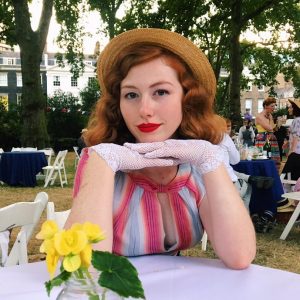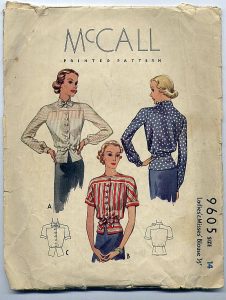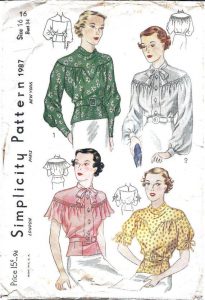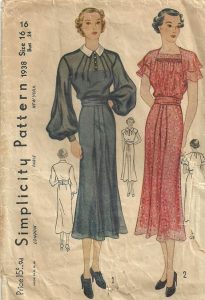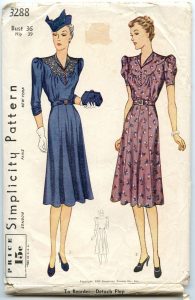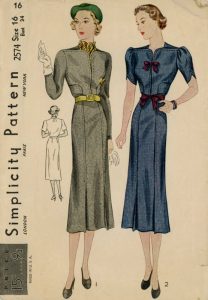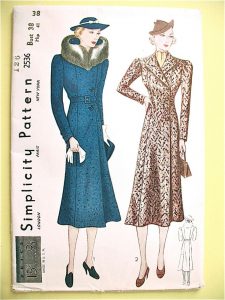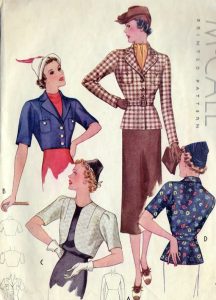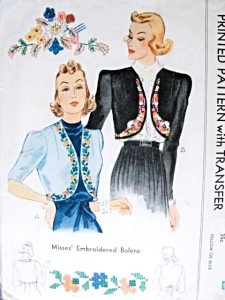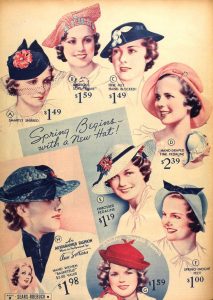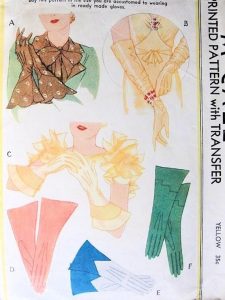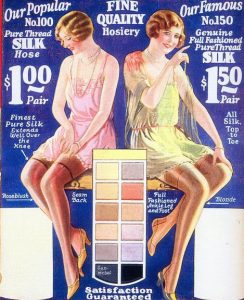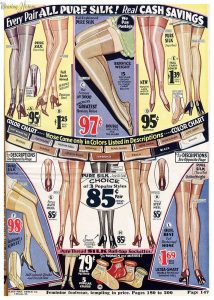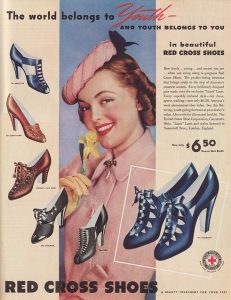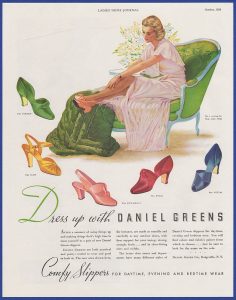1930s Spring Styles
Every year spring appears suddenly, catching us all off guard. We face the eternal question of what to wear during this ephemeral time. To help us, I have collected spring daywear style suggestions from various editions of the notorious fashion journal Women’s Wear Daily.This article will investigate what the fashionable women of the 1930s were wearing in spring.
Blouses
For spring, blouses featured ‘softened’ feminine collars, such as peter pan collars embroidered with flowers, and pussy bows. Stripes, polka dots, and florals dominated the prints. Stripes were also introduced in highly tailored vertical tucks and pleats, and florals in lace overlays on sheer blouses. Overblouses cinched at the waist were popular, sometimes featuring ruffles or a peplum. Tucked blouses were also popular, either full, long sleeves with tight cuffs, or short sleeves with contrasting trim. Silk and rayon was optimal for overblouses, while rayon crepe was popular for other styles.
Dresses
Both solid and patterned dresses were popular for spring. The dominant colours for both were black, navy blue, grey, and neutrals like brown and beige. Solid-coloured pieces served as a backdrop for the bright contrasting spring accessories. Print pieces would feature bright colours to which the accessories would be matched, usually against a dark background. Sheer fabrics were popular in dresses for warmer days, with cotton and rayon for intermediate days, and woolens for chillier ones.
Jackets/Coats
Two dominant themes appeared in the overwear department. For days with a lingering chill, coats in navy and beige were ideal, and were often paired with a dress in a matching colour. For warmer spring days, short jackets dominated. These could be hip or waist length, and were tailored to fit the body closely. Boleros were an especial favourite, being listed as the must-have jacket for spring throughout the decade.
Hats
In perhaps a more expected turn, baby blue, baby pink, and chartreuse were the most popular spring hat colours. Sailor-style hats trimmed with ribbons and flowers were particularly popular. As were ‘garden turbans’ comprised entirely of flowers, and floral trim on turbans in the contrasting colours already established in an outfit.
Gloves
In the 1930s, gloves were an integral accessory for every outfit. Due to their importance, they featured strongly in spring trends. Leather gloves in pastels such as forget-me-not blue, apricot, Gaugin rose, violet, and cyclamen were popular. Also in leather, bold bright spring colours were favoured, such as ‘new luggage tan’, oxblood red, gold, copper, ginger yellow, fuchsia, ‘biarritz green’, and marine blue.
Stockings
Another crucial accessory to complete any outfit was hosiery. To compliment any lively spring ensemble, stockings in warm pinkish tones were recommended. Light beige was popular for women who prefer neutrals, but someone more daring would have gone for apricot, azalea, blush pink, rose, or mauve. While these were intended for women with light skin tones, I believe they would look striking on anyone!
Shoes
Any outfit is incomplete without the perfect shoes. Spring shoe trends in the 1930s went two ways. Commonly they were neutrals, such as tan and white with water snake, or matched the colour of the dress or suit, in black, navy, brown, or grey. These were often oxfords, which were practical for spring’s unpredictable weather. Alternatively, shoes would have been a bright and bold statement, tying into the theme of contrast. In this category, colours such as violet, cyclamen, rose, and fuchsia were popular for spring, as well as shoes dyed to match a pair of statement gloves in any of the colours listed above. While women in the 1930s would have primarily worn heels, flats in these colours would look fabulous as well.
Overall, the catchword for spring in the 1930s was contrast.Dark dresses with vibrant trims and accessories were in vogue. Both pastels and bold vibrant hues were popular, offering variety and room for individuality. Floral embroidery and decorations took otherwise plain pieces and transformed them for springtime.

